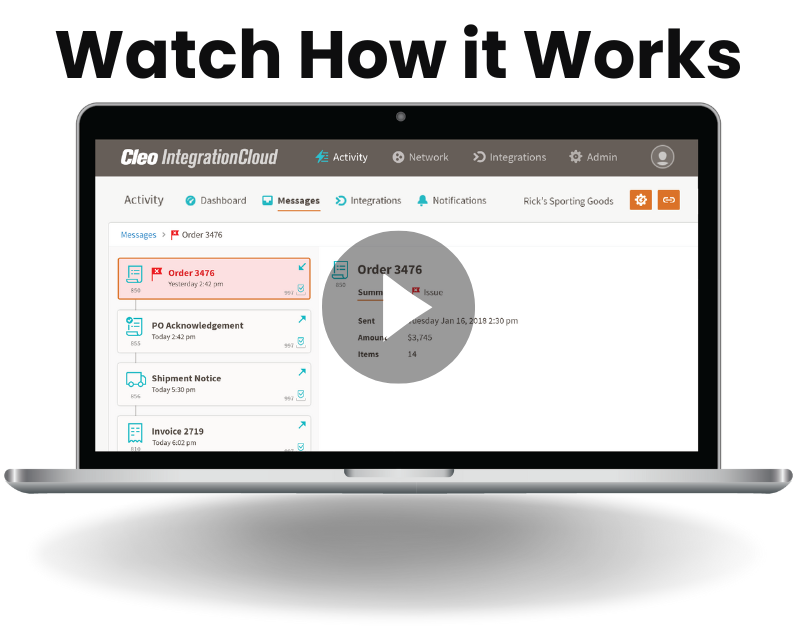7 Reasons Why B2B Integration Is Out of Control

Running a successful business is not an easy task. With countless moving parts, leaders oftentimes feel like they've lost control of their operations. This is especially true regarding the supply chain, even if they have EDI integration in place.
Not all EDI integration solutions are created equal, which unfortunately many organizations do not realize until it is too late and a solution has been implemented. Additionally, some organizations may not even realize their integrations are out of control because they do not know what other options are available.
In this blog, we will take a look at seven common reasons why B2B integration is often out of control. If you find that these reasons apply to your business and integrations, it may be time to consider alternative solutions.
1. Time-Consuming
2. Error-Prone
3. Inflexible
4. Very Costly
5. Just Slow
6. Limited Scalability
7. Lack of Visibility
1. Time-Consuming
EDI Integration is an integral aspect of your business and supply chain, and accordingly deserves the adequate support and resources it needs to ensure peak performance. However, that does not mean integration needs to be unnecessarily time-consuming.
For example, frequent integration issues that can consume and dominate integration managers' time include:
• Trading partner onboarding taking weeks or months
• Errors plaguing daily operations
• Regular system downtime
• Poor data-sharing and visibility
2. Error-Prone
Nobody likes when things do not go as planned. Integration issues are no different. Integration issues can lead to massive supply chain disruptions that impact your business, your trading partners' business, and their customers. These disruptions can lead to expensive trading partner fines and fees that harm a business's financials, vendor scorecards, and relationships with trading partners. Therefore, it is in a company's best interest to minimize the overall number of errors and how long it takes to fix them.
Frequent errors can stem from a variety of reasons, including:
• Using outdated/legacy technology
• Incorrect or missing information in the message
• Incorrect message sequence
• Delivery of the wrong document
• Manual processing
• Data structure is different than what was agreed upon
Integration errors prevent businesses from running smoothly, efficiently, and accurately, so reducing errors is key to regaining control.
3. Inflexible
Finding a great EDI solution is half the battle. A company also needs to consider the service options available with each solution.
For example, some service options include:
• Self-service: A company's internal team is responsible for installing and managing EDI processes
• Managed services: The provider fully installs and manages a company's EDI processes
• Blended services: For unique, or more complex organizations, customers select a combination of self-service and/or managed services that fits them best.
4. Very Costly
Integration is a tool to help your business grow and make more money. If the total cost of ownership is too high, the revenue it brings in will not be worth the effort.
The high cost usually stems from a few different factors, including:
• Product cost
• Consistent errors
• System downtime
• Supply chain disruptions
• Missed SLAs
• Annual fees
• Maintenance and service fees
• Deploying multiple solutions
Looking at the above list, product cost is only one aspect of integration costs. Another aspect altogether is lost revenue that would come into your company from having a more streamlined and efficient integration layer. And 99 percent of companies interviewed indicated in a recent survey that they know their companies ARE losing money due to poor integration. Yet such costly losses are altogether avoidable these days.
So if your company decides to go the cheapest route when picking a solution in order to save money, beware. Not only can the total fees can quickly add up but so can the revenue losses and profitability hits. If you simply go with the cheapest options that has the least amount of cutting-edge features, it may be a good Band-Aid solution but it will not operate any too well over the longer term.
5. Just Slow
Slow integration platforms often come in the form of traditional solutions such as EDI VANs and homegrown solutions. For example, onboarding new trading partners using a VAN can be especially slow and complicated. Additionally, VANs commonly offer a web portal to customers where they have to manually go into the portal and enter information about a particular document. While this may not be an issue for a smaller company starting out, this is not a scalable solution and will hinder growth. Not to mention manual entry increases the likelihood of errors which can halt supply chains.
When it comes to homegrown solutions, they too operate slower. This is because instead of buying a product from a specialized EDI provider that employs teams of experts that work on advancing the product day in and day out, a homegrown solution relies on one or a few internal employees.
6. Limited Scalability
Businesses love growth, as it tends to go hand-in-hand with more revenue. However, poor integration is a massive obstacle to business growth.
For example, if an integration solution cannot connect with all the various platforms and systems within a digital ecosystem, it becomes much harder for an organization to scale. This is because the company's supply chain is not fully integrated. Disjointed ecosystems are less efficient and more error-prone, which leads to delays and disruptions which slow down the entire order process and supply chain. Additionally, if an EDI integration solution cannot connect with a wide variety of trading partners, it severely limits new business opportunities, thus hindering growth.
7. Lack of Visibility
Subpar visibility can leave companies in the dark about their own operations and supply chains. Without visibility, companies are more likely to experience errors, disruptions, fees, inaccurate data, and more.
For example, if a logistics company has poor visibility they might not know an error occurred in their supply chain operations. Eventually, the supply chain is halted due to the error and the supply chain becomes disrupted. Only then does the logistics company realize something is wrong. The organization then has to figure out where the error is stemming from before it can even fix the problem. Since the supply chain is disrupted and its trading partners receive their goods or services late, the logistics company is then slapped with a fee, receives negative points on its vendor score, and harms its relationship with its trading partner.
Conversely, end-to-end visibility is critical for gaining control over EDI integration as it gives companies insight into their supply chains and operations. Visibility comes in the forms of error notifications and where the issues stem from, insight into EDI transactions (purchase orders, invoices, advanced shipping notices, etc.), and real-time data flows between connected systems in a digital ecosystem (EDI, ERP, TMS, WMS, CRMS, trading partners, etc.). These insights lead to improved data accuracy, more informed decision-making, quicker error resolution, and the ability to optimize processes based on KPIs.
Cleo is the Best Solution for Simplifying B2B Integration
Organizations often experience more than one of these seven integration issues at a time, since they tend to be intertwined. This compounds until their EDI and ecosystem integration are severely suffering and the company is left at a standstill.
That's why Cleo offers a variety of cutting-edge integration products and services to fit your exact business needs, allowing you to take control of your business and supply chains. So whether you need an on-premise or cloud solution, EDI or AS2 integration, self-service or managed services, or accelerators or connectors, Cleo has you covered.
Learn how leading organizations are tackling B2B integration
With our latest offering, Cleo Integration Cloud with RADAR, our customers gain end-to-end visibility into their digital ecosystems and supply chains, error notifications, business process automation, widespread integration and protocol support, real-time data, and more.
If you have questions about what was covered in this blog, EDI, or Cleo's products and services, contact us at sales@cleo.com or +1.815.282.7695. Lastly, explore some of our educational resources through our resource library.

About Cleo

Watch a Demo

Comprehensive Guide to Gaining B2B Control

Duraflame Case Study

